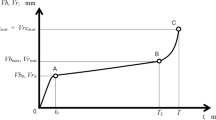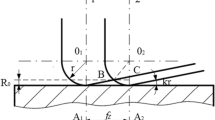Abstract
Online monitoring of surface roughness is a desirable capability for machining processes; however, 100 % inspection of all parts is not feasible unless it can be integrated into the machining process itself through real-time monitoring of cutting conditions. One strategy is to feed these conditions into a predictive modeling kernel which would in turn give the properties of the finished part. In the case of roughness, the surface resulting from turning can be largely represented as the trace of the passing tool geometry. The question addressed herein is whether computationally intensive modeling of the surface accounting for tool nose radius is necessary for online monitoring of surface roughness. This paper presents a predictive modeling methodology wherein the tool-workpiece contact position varies under a simple cutting model, and the resulting surface roughness is estimated. It presents the concept of calculating a “pseudo-roughness” value based only on tool tip locations and to compare this value to that determined by full predictive modeling of the tool geometry. Cutting experimental data has been presented and compared to predictions for model validation. It is found that the root mean square roughness calculation is dominated by tool geometry, rather than tool position deviations and surface roughness estimation could be implemented without a computationally intensive modeling component, thereby enabling online monitoring and potentially real-time control of the part finish.
Similar content being viewed by others
References
Moon KS, Sutherland JW (1994) Origin and interpretation of spatial frequencies in a turned surface profile. J Engr for Ind, Trans ASME 116(3):340–347
Selvam MS (1975) Tool vibration and its influence on surface roughness in turning. Wear 35(1):149–157
Rakhit AK, Sankar TS, Osman MOM (1976) Influence of metal cutting forces on the formation of surface texture in turning. Intl J Machine Tool Des Res 16(4):281–292
Klamecki BE (1989) On the effects of turning process asymmetry on process dynamics. J Engr for Indu, Trans ASME 111(3):193–198
Lin SC, Chang MF (1998) Study on the effects of vibrations on the surface finish using a surface topography predictive modeling model for turning. Intl J Machine Tools Manu 38(7):763–782
Cheung CF, Lee WB (2000) Modelling and predictive modeling of surface topography in ultra-precision diamond turning. Proc Institution of Mech Engrs, Part B: J Engr Manu 214(6):463–480
Cheung CF, Lee WB (2001) Characterization of nanosurface generation in single-point diamond turning. Int J of Machine Tools Manu 41(6):851–875
Cheung CF, Lee WB (2000) Theoretical and experimental investigation of surface roughness formation in ultra-precision diamond turning. Intl J of Machine Tools and Manu 40(7):979–1002
Chiou YS, Liang SY (1997) Chatter stability of a slender cutting tool in turning with tool wear effect. Intl J Machine Tools Manu 38(4):315–327
Wu DW (1988) Application of a comprehensive dynamic cutting force model to orthogonal wave-generating processes. Intl J Mechanical Science 30(8):581–660
Yan WY, Al-Jumaily AM (2005) Workpiece deflection compensation using a two-dimensional toolpost. Proc Ins Mech Engrs, Part K: J Multi-body Dynamics 219(4):393–400
Jang DY et al (1996) Study of the correlation between surface roughness and cutting vibrations to develop an on-line roughness measuring technique in hard turning. Intl J of Machine Tools Manu 36(4):453–464
DeVries WR (1992) Analysis of material removal processes. Springer, New York
Author information
Authors and Affiliations
Corresponding author
Rights and permissions
About this article
Cite this article
Damianakis, M.A., Bement, M.T. & Liang, S.Y. Kinematics prediction and experimental validation of machined surface roughness. Int J Adv Manuf Technol 65, 1651–1657 (2013). https://doi.org/10.1007/s00170-012-4286-x
Received:
Accepted:
Published:
Issue Date:
DOI: https://doi.org/10.1007/s00170-012-4286-x




